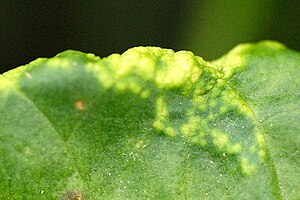Puccinia bistortae
| Puccinia bistortae | ||||||||||||
|---|---|---|---|---|---|---|---|---|---|---|---|---|

Puccinia bistortae |
||||||||||||
| Systematics | ||||||||||||
|
||||||||||||
| Scientific name | ||||||||||||
| Puccinia bistortae | ||||||||||||
| Candolle |
Puccinia bistortae is a stand fungal art from the order of the rust fungi (Pucciniales). The fungus is an endoparasite of angelica and French chestnut as well as of meadow knotweed . Symptoms of the infestation by the species are rust spots and pustules on the leaf surfaces of the host plants. It is common in Eurasia .
features
Macroscopic features
Puccinia bistortae can only be recognized with the naked eye by means of the spore beds emerging on the surface of the host. They grow in nests that appear as yellowish to brown spots and pustules on the leaf surfaces.
Microscopic features
The mycelium of Puccinia bistortae grows as with all Puccinia TYPES intercellular and forms Saugfäden that grow into the storage tissue of the host. Your spermogonia grow on both sides of the host leaves and are honey-colored. The aecia of the species growing on the underside of the leaves, on stems and on petioles are pustular, light yellow to orange and densely packed. Their yellow-orange aeciospores are 18–26 × 15–23 µm in size, spherical to polyhedral and finely warty. The uredia of the fungus growing underneath the leaves are yellow-red and uncovered early. Their light yellow-brown uredospores are spherical to ellipsoidal, 20-25 × 18-20 µm in size and spiky. The parts of the species growing underneath the leaves are dark brown, powdery and uncovered early. The yellow-brown teliospores are two-celled, usually broadly ellipsoid and 24–42 × 16–25 µm in size. Their stem is colorless and short.
distribution
The known distribution area of Puccinia bistortae covers large parts of Eurasia .
ecology
The host plants of Puccinia bistortae are the forest angelica and the French earth chestnut for the haplont and snake ( Polygonum bistorta ) and nodule knotweed ( P. viviparum ) for the dikaryote . The fungus feeds on the nutrients present in the storage tissue of the plants, its spore beds later break through the leaf surface and release spores. The species has a development cycle with Aecien, Spermogonia, Uredien and Telien and does not change host.
literature
- Ernst Gäumann: The rust fungi of Central Europe. With special consideration of Switzerland . In: Contributions to the cryptogam flora in Switzerland . tape 12 . Commission publisher Buchdruckerei Büchler & Co, Bern 1959.
